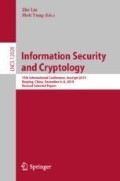Abstract
Laser-based fault injections (LFI) attack is a serious threat against cryptographic implementations. One of the effective countermeasures against LFI attacks is to detect the laser shot and delete the sensitive information before any leakage occurs. This paper focuses on an ASIC AES implementation protected by a laser sensor that can detect the irregular current caused by the laser shot and send the alarm signal. We experimentally show that the single-bit alarm signal generated by the laser sensor is a source of side-channel leakage that leaks the sensitive information of the AES calculation. Specifically, by adjusting the strength of the laser shot to achieve an unstable alarm signal, we demonstrate the most effective successful key recovery in our setup. Our results imply that the sensitivity of the on-chip sensor could leak the sensitive information of cryptographic calculation; thus they should be implemented with careful side-channel countermeasures.
Access this chapter
Tax calculation will be finalised at checkout
Purchases are for personal use only
References
Kocher, P., Jaffe, J., Jun, B.: Differential power analysis. In: Wiener, M. (ed.) CRYPTO 1999. LNCS, vol. 1666, pp. 388–397. Springer, Heidelberg (1999). https://doi.org/10.1007/3-540-48405-1_25
Brier, E., Clavier, C., Olivier, F.: Correlation power analysis with a leakage model. In: Joye, M., Quisquater, J.-J. (eds.) CHES 2004. LNCS, vol. 3156, pp. 16–29. Springer, Heidelberg (2004). https://doi.org/10.1007/978-3-540-28632-5_2
Oswald, D., Paar, C.: Breaking Mifare DESFire MF3ICD40: power analysis and templates in the real world. In: Preneel, B., Takagi, T. (eds.) CHES 2011. LNCS, vol. 6917, pp. 207–222. Springer, Heidelberg (2011). https://doi.org/10.1007/978-3-642-23951-9_14
Gandolfi, K., Mourtel, C., Olivier, F.: Electromagnetic analysis: concrete results. In: Koç, Ç.K., Naccache, D., Paar, C. (eds.) CHES 2001. LNCS, vol. 2162, pp. 251–261. Springer, Heidelberg (2001). https://doi.org/10.1007/3-540-44709-1_21
Agrawal, D., Archambeault, B., Rao, J.R., Rohatgi, P.: The EM side—channel(s). In: Kaliski, B.S., Koç, K., Paar, C. (eds.) CHES 2002. LNCS, vol. 2523, pp. 29–45. Springer, Heidelberg (2003). https://doi.org/10.1007/3-540-36400-5_4
Matsuda, K., et al.: A 286 \({\rm F}^{2}\)/cell distributed bulk-current sensor and secure flush code eraser against laser fault injection attack on cryptographic processor. J. Solid-State Circuits 53, 3174–3182 (2018)
Biham, E., Shamir, A.: Differential fault analysis of secret key cryptosystems. In: Kaliski, B.S. (ed.) CRYPTO 1997. LNCS, vol. 1294, pp. 513–525. Springer, Heidelberg (1997). https://doi.org/10.1007/BFb0052259
Piret, G., Quisquater, J.-J.: A differential fault attack technique against SPN structures, with application to the AES and Khazad. In: Walter, C.D., Koç, Ç.K., Paar, C. (eds.) CHES 2003. LNCS, vol. 2779, pp. 77–88. Springer, Heidelberg (2003). https://doi.org/10.1007/978-3-540-45238-6_7
Goodwill, G., Jun, B., Jaffe, J., Rohatgi, P.: A testing methodology for side-channel resistance validation (2011)
Skorobogatov, S.: Optically enhanced position-locked power analysis. In: Goubin, L., Matsui, M. (eds.) CHES 2006. LNCS, vol. 4249, pp. 61–75. Springer, Heidelberg (2006). https://doi.org/10.1007/11894063_6
Li, Y., Sakiyama, K., Gomisawa, S., Fukunaga, T., Takahashi, J., Ohta, K.: Fault sensitivity analysis. In: Mangard, S., Standaert, F.-X. (eds.) CHES 2010. LNCS, vol. 6225, pp. 320–334. Springer, Heidelberg (2010). https://doi.org/10.1007/978-3-642-15031-9_22
Moradi, A., Mischke, O., Paar, C., Li, Y., Ohta, K., Sakiyama, K.: On the power of fault sensitivity analysis and collision side-channel attacks in a combined setting. In: Preneel, B., Takagi, T. (eds.) CHES 2011. LNCS, vol. 6917, pp. 292–311. Springer, Heidelberg (2011). https://doi.org/10.1007/978-3-642-23951-9_20
Schellenberg, F., Finkeldey, M., Gerhardt, N., Hofmann, M., Moradi, A., Paar, C.: Large laser spots and fault sensitivity analysis. In: Robinson, W.H., Bhunia, S., Kastner, R. (eds.) HOST 2016, pp. 203–208. IEEE Computer Society (2016)
Shamir, A.: Protecting smart cards from passive power analysis with detached power supplies. In: Koç, Ç.K., Paar, C. (eds.) CHES 2000. LNCS, vol. 1965, pp. 71–77. Springer, Heidelberg (2000). https://doi.org/10.1007/3-540-44499-8_5
Plos, T.: Evaluation of the detached power supply as side-channel analysis countermeasure for passive UHF RFID tags. In: Fischlin, M. (ed.) CT-RSA 2009. LNCS, vol. 5473, pp. 444–458. Springer, Heidelberg (2009). https://doi.org/10.1007/978-3-642-00862-7_30
Schmidt, J.-M., Plos, T., Kirschbaum, M., Hutter, M., Medwed, M., Herbst, C.: Side-channel leakage across borders. In: Gollmann, D., Lanet, J.-L., Iguchi-Cartigny, J. (eds.) CARDIS 2010. LNCS, vol. 6035, pp. 36–48. Springer, Heidelberg (2010). https://doi.org/10.1007/978-3-642-12510-2_4
Gnad, D.R.E., Krautter, J., Tahoori, M.B.: Leaky noise: new side-channel attack vectors in mixed-signal IoT devices. IACR Trans. Cryptogr. Hardw. Embed. Syst. 2019, 305–339 (2019)
Acknowledgement
This work was supported by JSPS KAKENHI Grant Number JP18H05289 and 19K21529.
Author information
Authors and Affiliations
Corresponding author
Editor information
Editors and Affiliations
Rights and permissions
Copyright information
© 2020 Springer Nature Switzerland AG
About this paper
Cite this paper
Li, Y. et al. (2020). Side-Channel Leakage of Alarm Signal for a Bulk-Current-Based Laser Sensor. In: Liu, Z., Yung, M. (eds) Information Security and Cryptology. Inscrypt 2019. Lecture Notes in Computer Science(), vol 12020. Springer, Cham. https://doi.org/10.1007/978-3-030-42921-8_20
Download citation
DOI: https://doi.org/10.1007/978-3-030-42921-8_20
Published:
Publisher Name: Springer, Cham
Print ISBN: 978-3-030-42920-1
Online ISBN: 978-3-030-42921-8
eBook Packages: Computer ScienceComputer Science (R0)

